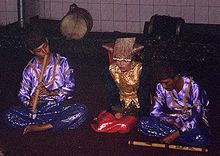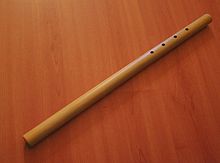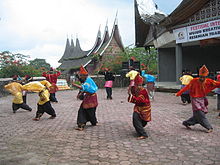Saluang

Saluang is an end-blown open core gap flute made of bamboo , which is played by the Minangkabau in the highlands of the Indonesian province of West Sumatra . The musical instrument reserved for men mostly accompanies folk songs called dendang .
distribution
The saluang belongs to a series of several end-blown bamboo flutes common in the Southeast Asian island world, which are commonly called suling up to the Philippines . There are also local language names such as seruling in Malaysia . In Java and Bali the suling is played in the gamelan orchestra, as well as in the western Javanese cultural region of Sunda with the orchestral line-up gamelan degung and in the musical styles tembang Sunda with singing and kacapi suling without singing, both times with suling and the boat-shaped zither kacapi . At the beginning of the 20th century, Curt Sachs mentioned the signal whistle salunding among the Dayak in Borneo , not to be confused with the Balinese metallophone of the same name made of iron plates. In Aceh , in northern Sumatra, a thin bamboo flute with six finger holes is called suleng .
Saluang music is popular throughout the highlands populated by Minangkabau, especially in the central administrative districts ( kabupaten ) of Agam and Solok. There are several variants of the Minangkabau flutes with different names according to size or region. The bansi is likely to come from India or Persia , at least in name , and like the gambus lute, it was introduced with Muslim traders in the Middle Ages. The most famous North Indian bamboo flute is called bansuri . Muslims also brought the double-reed instrument surnai , whose Arabic name mutated to sarunai among the Minangkabau . The Portuguese, who founded settlements in Sumatra from the 16th century and distributed European musical instruments, exerted a different influence not only on the flutes.
Design
The shape and the soft sound with a high proportion of noise are similar to the Japanese Shakuhachi . Most flutes are 65 to 75 centimeters long with an inner diameter of 2.5 centimeters; they have four finger holes and five to six in the outskirts of the Minagkabau settlement area . The flutes are played cross-legged on a mat and held to one side at a slight angle to the lips so that the vent opening is not completely closed. All flutes are blown with circular breathing (Minang language: manyisiahkan angok , “to take the breath to one side”, Indonesian: menyisihkan napas , “to go aside, to separate - breath”). Individual Saluang are:
Saluang darek is the most famous flute. Darek means "highlands" in contrast to pesisir , "coastal region", as well as "homeland" in contrast to rantau , "settlement in a foreign country, foreign country". The name Darek consequently describes the narrower traditional settlement area of the Minangkabau, which is also known as Luhak Nan Tigo . The flute is on average 60 centimeters long and is made with different lengths for three pitches. The subtribe Schizostachyum brachycladum ( Indonesian : bambu talang ), belonging to the Bambuseae , is used as material, which stores a particularly large amount of water. Old bamboo cane or bamboo cane fished out of the water as driftwood is often preferred. The instrument is tuned to a pentatonic scale, other pitches are possible by using fingering combinations and half covering the finger holes. The saluang darek is mainly used to accompany the saluang jo dendang ("flute and song").
The saluang Sirompak is a little longer at 70 to 75 centimeters, it has five finger holes on the top and a thumb hole on the bottom. The length results in a pitch one octave lower. Ten notes result in a range of two octaves. Magical powers ( pitunang ) for hypnosis of the audience were ascribed to the flute tones . Because of this, and although women could have been seduced with them, the saluang Sirompak , which is only known in the area of Payakumbuh , is rarely heard today.
Also once regarded as magical and only around Payakumbuh northeast of Bukittinggi there is the simpelong , also sampelong , for sad instrumental music or vocal accompaniment. The sampelong is about 54 centimeters long with four finger holes on the top and has a diameter of 3.5 centimeters.
The Saluang Pauah is closed at the lower end ( Gedackt ) and with a wooden reed provided. The instrument with six finger holes is tuned heptatonic , a little over 40 centimeters long and 9.5 centimeters in diameter. The pitch range of one octave ranges from e to e1. Higher notes can be played with higher air pressure. It is also used for song accompaniment ( dendang ), but less often than the saluang darek. There are only five traditional melodies for this instrument, but a large number of stories can be set to music.
Saluang Panjang ("long flute"), also saluang Sungai Pagu after its origin in the district of the same name ( kerajaan ) in the district ( kabupaten ) Solok Selatan. According to its name, the instrument is 72 to 80 centimeters longer than the others, but has only two finger holes on the top and one hole at the bottom. With the appropriate blowing technique, eight tones can be produced. It is used almost exclusively for songs called dendang Sungai Pagu .
The bansi is slightly smaller than the saluang Pauah , otherwise similar, like this one, it has a reed, six finger holes at the top and a thumb hole at the bottom. It uses a diatonic (heptatonic) scale. Their area of origin is Kabupaten Pesisir Selatan, the coastal region in the southwest of Western Sumatra. The melodies played on the bansi , with or without singing , are relatively simple when it comes to private entertainment. Otherwise it is used together with a talempong (several humpback gongs in a double row, similar to a Javanese bonang ) for dance accompaniment and for theater performances such as the Randai dance theater . On the coast, the musical influences from Arab countries, India and the Portuguese are stronger than in the highlands.
Style of play
The Minangkabau have a highly developed narrative culture in which historical stories and myths are passed on after strict observance of tradition ( adat ). The narratives form the content of vocal performances and popular theaters, both of which can be entertaining or take place as part of a religious ceremony. Occasions for performances include family celebrations, housewarming ceremonies, Thanksgiving, and Islamic holidays. The actual program starts in the evening and can last until the early hours of the morning. As extensive as the verses are, the accompanying melodies on the flute sound quite sparse. The tones usually fluctuate in the range of a fifth or less and rarely go beyond this.
Saluang jo dendang
The saluang jo dendang singing style is popular in the highlands ( darek ) and among migrants (in rantau ). It is performed at family celebrations and public parties where the musicians play pieces on demand and money is collected for a specific purpose ( malam bagurau ). The flutist begins with a slow introduction, which circles around a few notes and provides a solemn, melancholy mood. This is followed by a singer ( badendang ) with a pantun verse. A heterophonic interplay takes place between the basically free rhythm sung performance of this old form of poetry, which is widespread in large parts of Indonesia and Malaysia, and the flute . Two or three singers can take turns singing the verses, but they almost never sing at the same time. The lecture ends with a flute solo. The lyrics are sadiah , as usual with Pantun, they are about love affliction or give well-meaning advice to the audience. The repertoire dominated by the Minangkabau singers includes over 400 Pantun texts, the musical sequence can be improvised.
The verses are not tied to specific songs, they are selected by the singer from his repertoire during the performance. Although every Minang knows some of these verses, the demands of the audience at the events are so high that practically only professional musicians can perform. Many of these verses belong to the genus lagu asal (Indonesian, "song from the place of origin", also lagu pusako , "ancestral song") and are named after the area from which they come. The name of the place of origin is usually mentioned in the first line. The local musical traditions found their way into the general Minang cultural heritage.
Saluang music is classified according to mood : the largest group is made up of the sad songs ( ratok ). This also includes those that begin with the word Singgalang, i.e. from the area around Gunung Singgalang. There should be 120 of these songs. They are noticed by the flute swinging between closely spaced tones. The other style is metric and is called gambira ("joy") or at least setengah gambira ("half joyful"). Another classification is made according to the finger position on the flute: In some songs, preferably those from the coastal region ( pesisir ), the instrumental introduction ends on a note for which all finger holes are closed (corresponds approximately to the note C). In the next group three finger holes are closed and only the one furthest away is open (tone D). This includes most of the sad chants ( ratok ). Compositions that end in E and F, i.e. with two or one covered finger hole, form the other two categories. Songs from the Danau Maninjau region end with two closed finger holes . The one-hole category remains, to which the sung poetry sijobang is counted.
Malam bagurau is a privately organized event to raise money for a specific project, for the construction of a new mosque or for a social cause. The musicians are invited and paid by the sponsor, the viewers donate for each music request and often increase each other so that the musicians switch to the next desired song after a few verses. The competition between the audience can drive the price of a song from a few cents to astonishing heights. Audience favorites are songs from the ratok and gambira genre, as well as some with somewhat suggestive content.
The wedding celebrations that lasted several days include a modern pop band with keyboards for the younger participants on the evening of the main celebration, which plays until midnight, and for the older ones a more adat-like Saluang performance with a flute player and several singers. They perform love songs dressed in Pantuns from a female perspective with great directness and sexual innuendos.
Other styles of music
Dendang Pauah , like sijobang and rabab Pariaman ( spike fiddle rabab with singing), is one of the musical forms with narrative content called kaba (from Indonesian kabar , "news"). Their content ranges from mythical stories to current events. The dendang Pauah style comes from the region around Padang , the capital of Western Sumatra on the coast. Accompanied by a flute player with a bansi , the singer only sings pantun verses. Since most musical phrases of the flute solo ( pado-pado ) end with the lowest note with all six finger holes closed, these are called pakok anam ("six closed"). The other sections of the piece also have characteristic names. The performances last from evening until just before dawn. The beginning is the flute solo, followed by several sections with different melodies of flute-vocal interplay and a final vocal solo.
For entertainment celebrations also Saluang groups can be hired on a stage that exist alongside the flute players and the singers even from a singer who at the same time, the three-stringed spike fiddle rabab plays the functional equivalent of the Batak -Zupflaute hasapi .
Randai is a traditional folk theater that is performed in Western Sumatra by around 250 active groups of players at religious ceremonies and festive events. In addition to dances, scenic drama and music, the theater also includes the martial art of silek , which was developed in Western Sumatra independently of the Malay martial art of silat . The minimal orchestral line-up for the randai consists of a saluang , a talempong , which here consists of a series of five humpback gongs that are struck with sticks, and a gandang katindik . This is a two-headed medium-sized drum that can be beaten by hand or with a stick. A larger orchestra also includes the flutes bansi and sampelong , the oboe sarunai , other drums and, occasionally, strings of the rabab type.
Similar to the way older pop music styles such as Kroncong , Tanjidor or Jaipongan faded into the background in West Java in the last decades of the 20th century due to the Schlager-like Dangdut music, the catchy four-four time dangdut in the Minangkabau developed under the umbrella term Pop Minang music categories which are called saluang dangdut or saluang disco and can be heard everywhere because they are sold as canned audio in every music store.
See also
- Salawek dulang , the seated dance of the Muslim Minangkabau at family celebrations
Discography
- Night Music of West Sumatra. Saluang, Rabab Pariaman, Dendang Pauah. Music of Indonesia 6. Smithsonian / Folkways, 1994
literature
- Margaret J. Kartomi, Artur Simon , Rüdiger Schumacher: Indonesia. In: Ludwig Finscher (Hrsg.): The music in past and present . Sachteil 4, 1996, Col. 835 f.
- Margaret J. Kartomi: Sumatra. In: Terry E. Miller, Sean Williams (Eds.): The Garland Encyclopedia of World Music. Volume 4: Southeast Asia. Garland, New York / London 1998, p. 610 f.
- Margaret J. Kartomi: The Music-Culture of South-Coast West Sumatra: Backwater of the Minangkabau "Heartland" or Home of the Sacred Mermaid and the Earth Goddess? In: Asian Music, Vol. 30, No. 1. Fall 1998 – Winter 1999, pp. 133–181
- Peggy Reeves Sanday: Women at the Center: Life in a Modern Matriarchy. Cornell University Press, London 2004, pp. 149-170
Web links
- Gabriela Szabová: Musical Instruments and Genres among the Minangkabau, West Sumatra. (PDF; 1.0 MB) Bachelor thesis, Palacký University , Olomouc 2008
- Saluang. Mentawi Paradise
- Saluang Jo Dendang "Singalang Mintak Tabia". Youtube video (Saluang and female singing voice)
Individual evidence
- ^ Curt Sachs: Real Lexicon of Musical Instruments, at the same time a polyglossary for the entire field of instruments. Julius Bard, Berlin 1913, p. 364
- ↑ Kartomi, MGG, Col. 835
- ↑ Informasi spesies: Bambu Talang. plantamor.com
- ↑ Kartomi, Garland, p. 611
- ↑ Gabriela Szabová, pp. 36–41
- ↑ The exception is the duet Padang Magek , which belongs to the genus lagu asal . Track 1 of the Smithsonian CD
- ↑ Kartomi, MGG, Col. 835
- ^ Sanday, p. 154
- ^ Sanday, p. 155
- ↑ Cf. Nigel Philips: Sijobang: Sung Narrative Poetry of West Sumatra (Cambridge Studies in Oral and Literate Culture). Cambridge University Press, Cambridge 1981, ISBN 978-0-521-23737-6
- ^ Philip Yampolsky, booklet for the Smithsonian CD
- ^ Philip Yampolsky, booklet for the Smithsonian CD
- ↑ Sanday, pp. 149-154
- ^ Kirstin Pauka: Theater & Martial Arts in West Sumatra: Randai & Silek of the Minangkabau. Ohio University Press, Athens 1999, pp. 26-28, 49, 100
- ↑ Bart Barendregt: The Sound of 'Longing for Home'. Redefining a Sense of Community through Minang Popular Music. Bijdragen tot de Taal-, Land- en Volkenkunde, 158, No. 3, Leiden 2002, pp. 411–450, here p. 436

